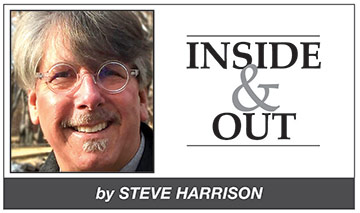Heritage walking tour along Route 66
by John Neiuber
The fourth part of our tour of Claremont begins at Foothill and Claremont Boulevards, on the famous Route 66. Begin on the north side of Foothill and proceed west to “get your kicks.”
FOOTHILL BOULEVARD: ROUTE 66
Foothill Boulevard was opened through Claremont as a state highway in January 1930, and became part of the famous Route 66—The Mother Road. Claremont’s Route 66 has several buildings that reflect the academic, citrus and business history of the town.
Proceed west on Foothill Boulevard.
MILLARD SHEETS STUDIO, 1958
655 E. FOOTHILL BLVD., north side of Foothill
This unique building was the design studio for the late Millard Sheets, who taught at Scripps College. Sheets became a nationally known artist and designer whose buildings and murals are found all over Southern California. Note the mosaic birds on the south wall.
Continue west on Foothill. Proceed north on College to reach the California Botanic Garden.
CALIFORNIA BOTANIC GARDEN, 1952
1500 N. COLLEGE AVE., north side of Foothill
Formerly the Rancho Santa Ana Botanic Garden, the purpose of this 86-acre garden is to study and preserve California native plants. The institution moved here from Santa Ana in the early 1950s to affiliate with the Claremont Colleges. The garden is open to the public and offers educational programs for adults and children, as well as summer concerts and plant sales.
Head back south the Claremont School of Theology that you passed going to the garden.
CLAREMONT SCHOOL OF THEOLOGY, 1952
1525 N. COLLEGE AVE., north side of Foothill
The campus is home to the mid-century masterpiece, Kresge Chapel. The School of Theology moved here from the University of Southern California in 1952. Its buildings were designed by Edward Durrell Stone, who also designed the Harvey Mudd College campus.
Continue west on Foothill Boulevard. Wolfe’s Marketplace is on the south side.
WOLFE’S MARKETPLACE, 1917
160 W. FOOTHILL BLVD., south side of Foothill
A fourth generation Claremont business, Wolfe’s Market was established in 1917 and is one of the oldest continuing operating businesses in the city. Once a full service local market that occupied the entire building, Wolfe’s is now a specialized deli, gourmet kitchen and catering business. The Meat Cellar occupies the majority of the footprint of where the market once operated.
Continue west on Foothill
GRISWOLD’S STONE CELLAR
222 W. FOOTHILL BLVD., south side of Foothill
This building was once the center of an extensive dried fruit and marmalade business run by a retired professor, George Griswold. It was a regular stop for travelers on Route 66. The business was moved across Foothill and expanded to include the original Griswold’s Inn now replaced by Buca di Beppo, Piano Piano and the DoubleTree Hotel by Hilton.
METHODIST CHURCH CHAPEL, 1960
211 W. FOOTHILL BLVD., north side of Foothill
The sanctuary of the Claremont United Methodist Church was designed by the internationally known Modernist architect, Richard Neutra. In 1967, the building was gutted by fire and Dion Neutra, son of the architect, was hired to rebuild the church.
Proceed west and cross Indian Hill Boulevard.
OLD SCHOOL HOUSE, 1911
415 W. FOOTHILL BLVD., north side of Foothill
This building, originally Claremont High School, opened its doors to a student body of 120 on September 2, 1911. After the Long Beach earthquake, it was extensively remodeled in the 1930s, having its third story removed for fear of collapse. Because it still did not meet earthquake standards for public schools, it was sold in 1971. It is now the Old School House restaurants, shops and offices. The Candlelight Pavilion dinner theater operates in the former gymnasium of the high school.
SHERWOOD FLORIST, 1923
404 W. FOOTHILL BLVD., south side of Foothill
The stone building with red tile roof was built to house the Sterling Oil Spray Company, which serviced the citrus industry. It later became a garage but now houses a florist shop. A unique anchor at a key corner in Claremont, it is a reminder of the rocky soil encountered and conquered by the early citrus ranchers.
Continue west on Foothill Boulevard.
DOUBLETREE BY HILTON, BUCA DI BEPPO
555 W. FOOTHILL BLVD., north side of Foothill
This site was once the location of the world famous Griswold’s Inn and Smorgasbord, a favorite with locals and travelers alike. George Griswold had moved his business selling dried fruit and marmalade from 222 W. Foothill and expanded it to a restaurant and inn. The inn would eventually become the Claremont Inn and the restaurant a smorgasbord. Claremont had been a “dry” town and the restaurant became the first place in Claremont to sell alcohol in 1968.
Continue on Foothill to Mountain Avenue.
THE CITY TREE
SOUTHWEST CORNER OF FOOTHILL AND
MOUNTAIN AVENUES
Here you will notice a tree surrounded by landscaping. This is the City Tree; the tree that was the inspiration for the creation of the city logo. The logo is a strong and perfect symbol for the City of Trees. The logo reminds one of a native tree, an oak or sycamore. But the tree one sees at the corner is neither—it is an avocado tree. The logo was the result of a city-wide design contest and was designed by Adele Schoene, who was awarded $25 for her winning entry.
Proceed north on Mountain Avenue.
THE JOHNSON HOUSE, 1907
1333 N. MOUNTAIN AVE.
This was the home of Dr. C.W. Johnson, who owned 160 acres from Foothill to Base Line on both sides of Mountain. The house was designed by Robert Hall Orr, who designed a number of other well-known Claremont buildings. Dr. Johnson never practiced medicine in California, but instead had orange groves, investments in Klondike gold and sold water from his reservoirs to other Claremonters.
This concludes Part 4 of our tour of Claremont. The tour will continue at Towne Avenue and Base Line Road.








0 Comments